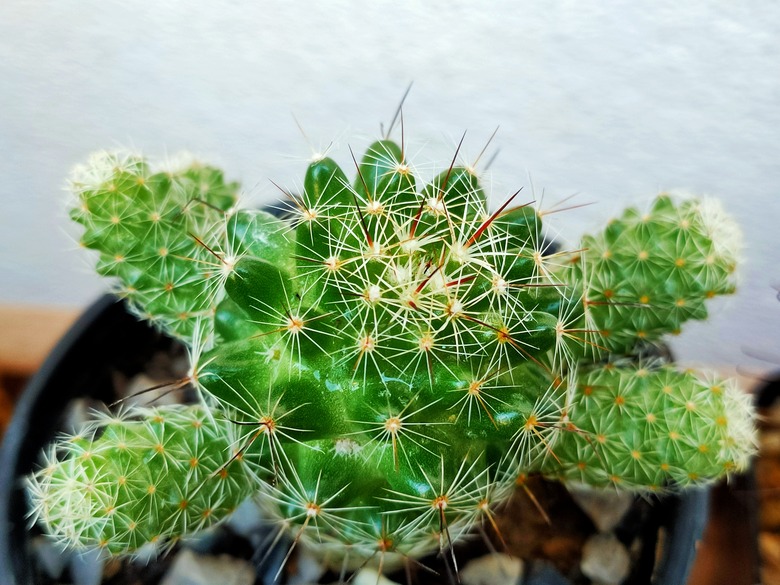How To Clone A Cactus
We may receive a commission on purchases made from links.
Cacti are members of the Cactaceae plant family, which contains both desert and tropical succulent plants. Cacti are distinguished from other succulents by the raised, round "bumps" on their skin known as areoles, which produce spines, hairlike bristles and flowers. Hardy in U.S. Department of Agriculture plant hardiness zones 3 through 12, depending on the species and cultivar, cacti are easy to reproduce. To clone a cactus, simply take a cutting or separate a pup from the parent plant and root it. Make sure your cactus is not patented, because propagating patent-protected plants is an illegal practice.
Start With Safety
Start With Safety
Begin by sterilizing your cutting tools. Dip the blades of your knife, scissors or pruners in rubbing alcohol or a household cleaner, like Lysol or Pine-Sol. Put on safety glasses as well as rose gloves to protect your hands from the cactus if it has spines. Use newspaper folded into a long, thick strip and wrap it around the cactus to hold it in place while snipping off cuttings or removing the babies, or pups, from the parent plant.
Clone a Cactus With Cuttings
Clone a Cactus With Cuttings
Take cuttings of desert cacti by removing a 3- to 4-inch cutting from an actively growing stem, or remove a thick, fleshy pad. Make sure that stem cuttings have one or two nodes. Set the cuttings, whether stem or pad, aside for several days so the cut ends callous over.
Tropicals like the Christmas (Schlumbergera russelliana), Thanksgiving (Schlumbergera truncata) and Easter (Schlumbergera gaertneri) cacti have flattened stem segments that serve as their "leaves." Hardy in USDA zones 10 through 12, these South American natives are epiphytes and live in the branches of tropical trees. Take a cutting consisting of two to five segments and set it aside to develop a callous.
Insert the cutting into moistened cactus potting mix, perlite or coarse sand. Be sure at least one node is buried in the mix. If you're starting a tropical cactus, put the cutting and pot into a plastic bag to increase the humidity. Set the cutting in a warm, brightly lit location out of direct sunlight, water when the mix begins to dry out and in a month or two, you should see new growth.
Reproduce Cacti With Pups
Reproduce Cacti With Pups
Some cacti, such as the lady fingers or powder puff cactus (Mammillaria spp., zones 8-10) and crown cactus (Rebutia spp., zones 9-11), also reproduce by growing offsets around their perimeter. Also known as babies or pups, these offsets are identical to the parent cactus. These small, slow-growing cacti thrive as houseplants indoors.
Separate the pups from the parent cactus using a sharp knife to cut through the attaching flesh and/or roots. Set the pups aside to let the cut ends dry and callous over. Wait a few days to water the parent plant to avoid fungal infections and root rot.
Place the cutting in a moist cactus mix. Set it in a brightly lit, warm location out of direct sunlight. Water lightly just to keep the mix barely moist until new roots appear. Once the cactus has developed new roots and is actively growing, begin applying a fertilizer formulated for cacti and succulents.
Water and Fertilize Your Cactus
Water and Fertilize Your Cactus
Water your desert cactus when the soil is dry. Christmas and other holiday cacti should never be allowed to completely dry out, as they are tropical plants and need water and humidity to thrive.
Never allow your cactus, whether desert or tropical, to sit in water. Add water until it drains from the flowerpot and then empty the saucer. When cactus growth slows, generally in winter, reduce watering but mist occasionally.
Fertilize cacti with a cactus fertilizer when they are actively growing. Always water thoroughly after fertilizing to protect the roots from the fertilizer salts. If a white crust develops on top of the soil, put the cactus in the sink and let lukewarm water drain through the mix to dissolve the salts and flush them from the potting mix. Alternatively, repot the cactus in a fresh potting mix.
